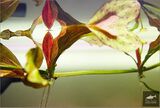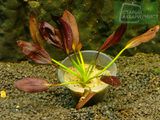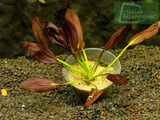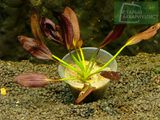Echinodorus Red Flame

Origin / Breeder : Hans Barth, Dessau[1]
It is a cultivated form of Echinodorus Ozelot. It was bred by Hans Barth Dessau in the late 1990s and was first offered for sale in 1998. The plant forms a compact bush of large oval leaves gathered in a rosette with slightly wavy edges. Under water, they reach a length of 10-20 cm and a width of 3-5 cm. Considering the size of the leaf stalks, the plant can grow up to 40 cm. Old and fully developed leaves have a deep red color with greenish veins. The swaying of the bushes of this plant in the water vaguely resembles tongues of flame, which is why the breeders gave this variety its name. Echinodorus Red Flame also thrives in open, humid greenhouses. In the air, however, it differs significantly from the underwater form. The plant grows up to 1 meter high. The leaves are green with barely perceptible red dots. Considered quite capricious when grown at home. Requires nutrient-rich soil, warm, slightly acidic, soft water. However, Echinodorus can adapt to other pH and dGH values. The intensity of the red coloration of the leaves depends on the degree of illumination - the higher, the brighter the color. It is also recommended to provide a supply of carbon dioxide.
Echinodorus Red Flame produces very conspicuous dark red spots on its reddish-brown leaves. The oldest leaves gradually become looser and juicier green. In the aquarium, the plant forms a rosette of leaves up to 30 cm high. Narrow-ovate, with a leaf stalk of up to 10 cm, leaf blades reach a length of 20 cm and a width of up to 10 cm. The plant is unpretentious, nutritious soil stimulates growth. Propagated by daughter plants on a flowering shoot. Much less frequently, old bushes form young bushes from dormant buds on the back of the rhizome. Propagation by division of the rhizome is also successful, but in this case too many buds usually germinate at the same time and young plants begin to interfere with each other, and if they are separated, development slows down dramatically.[2]
-
Echinodorus Red Flame[2]
-
Echinodorus Red Flame[2]
-
Echinodorus Red Flame[2]
-
Echinodorus Red Flame[3]
-
Echinodorus Red Flame[3]
-
Echinodorus Red Flame[3]
-
Echinodorus Red Flame[3]
- ↑ Christel Kasselmann, Taschenatlas Aquarienpflanzen ISBN:9783800159093 https://www.christel-kasselmann.de/
- ↑ 2.0 2.1 2.2 2.3 Kostiantyn Loboda, Black Water http://echinodorus.com.ua/
- ↑ 3.0 3.1 3.2 3.3 Roman Trifonov, Moskau Aquarium Pflanzen http://www.staraqua.ru/







